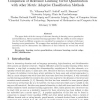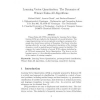IVC
2007
14 years 7 months ago
2007
The problem of clustering is often addressed with techniques based on a Voronoi partition of the data space. Vector quantization is based on a similar principle, but it is a diffe...
NN
2006
Springer
14 years 7 months ago
2006
Springer
The paper deals with the concept of relevance learning in learning vector quantization and classification. Recent machine learning approaches with the ability of metric adaptation...
NN
2006
Springer
14 years 7 months ago
2006
Springer
Learning vector quantization (LVQ) constitutes a powerful and intuitive method for adaptive nearest prototype classification. However, original LVQ has been introduced based on he...
PR
2008
14 years 7 months ago
2008
In this paper, we extend the conventional vector quantization by incorporating a vigilance parameter, which steers the tradeoff between plasticity and stability during incremental...
NCA
2008
IEEE
14 years 7 months ago
2008
IEEE
The conventional channel-optimized vector quantization (COVQ) is very powerful in the protection of vector quantization (VQ) data over noisy channels. However, it suffers from the ...
CORR
2007
Springer
14 years 7 months ago
2007
Springer
Self-organizing maps (SOM) are widely used for their topology preservation property: neighboring input vectors are quantiÿed (or classiÿed) either on the same location or on nei...
IJON
2006
14 years 7 months ago
2006
Winner-Takes-All (WTA) prescriptions for Learning Vector Quantization (LVQ) are studied in the framework of a model situation: Two competing prototype vectors are updated accordin...
IJON
2008
14 years 7 months ago
2008
Various alternatives have been developed to improve the Winner-Takes-All (WTA) mechanism in vector quantization, including the Neural Gas (NG). However, the behavior of these algo...
CORR
2006
Springer
14 years 7 months ago
2006
Springer
In vector quantization the number of vectors used to construct the codebook is always an undefined problem, there is always a compromise between the number of vectors and the quan...
CORR
2010
Springer
14 years 7 months ago
2010
Springer
Segmenting a MRI images into homogeneous texture regions representing disparate tissue types is often a useful preprocessing step in the computer-assisted detection of breast canc...






